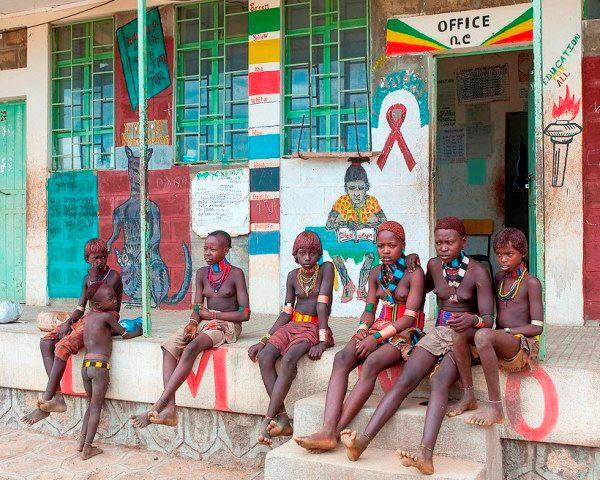
Ethiopian Education

Figure 1.--Ethiopian children like most children in Africa wear European-stled clothing or uniforms in European styles. A a rare exception are tribal children in the Omo Valley. This is a school in Turmi. Turmi is a market town in southwestern Ethiopia situated in the Debub Omo Zone of the Southern Nations, Nationalities, and People's Region.
|
|
Formal education began in Ethiopia before anywhere else in Sub-Saharan Africa. Christianity wa the state religion and the Christian Chutch controlled education (4th century AD). As in Europe, during the medieval era, only a small fraction of the population received any education. After the fall of Rome (5th century AD), Ethiopia was still in contact with Christian Europe. This change with the Arab outburst. Arab armies conquered Egypt and North Africa (7th century AD). Ehiopia thus spent centuries without any contact with Western Christendom and thus not exposed to major movements like the Renaissance, Reformation, and Englightenment that transformed education in Europe. Ehiopia became wrapped in a medieval time warp, much as the Muslim world.
Education remained in the hands of the Church and schooling was seen as the preserve of Ethiopia's ruling urban Amharic minority.
This did not begin to change until the Italian invasion (1935). The Italins began setting up European styles public schools, but only in the cities After World War II, the restored Ethiopian Government expanded the initial small Italian effort (1950s). This ended the hold on education of the Amharic minority and education became available to all children. The structure the Ethiopian educational system despite a revolutionary Communist regime has remained largely unchanged from that established when the modern Ethiopian school system was founds in the 1950s. Formal education in Ethiopia consists of six years of primary school, two years of junior elementary, and four years of senior secondary. Most children begin school at age 5 years. Ethiopia continues to be a poor country, and the school system is not adequately financed. This is a problem throughout Africa, The average class size is an incredible 65 students. Virtually no school supplies are available to the children. Most children lack pencils, books, and paper. Schools outside the cities and larger towns often lack water or useable toilets. Corporal punishment is common and widely accepted in Ethiopian schools. As in the rest of Africa, Ethiopian schildren generally wear European-style clothing or uniforms. There are many school uniforms in Ethiopia. They appeared only in the 1990s. When the Communists and Haile Selassie reigned, there were no school uniforms. The school uniforms are mainly red, blue and greenr. There are also red-white and black-white uniforms. A HBC reader also reports yellow shirts and blue trousers. Boys wear a shirt, jacket and trousers in different colors. Girls mainly wear a dress and sweater in different colors. One exception to the European style uniforms is the Omo Valley where tribal children commobly wear traditional garments.
HBC-SU

Related Chronolgy Pages in the Boys' Historical Web Site
[The 1880s]
[The 1890s]
[The 1900s]
[The 1910s]
[The 1920s]
[The 1930s]
[The 1940s]
[The 1930s]
[The 1940s]
[The 1950s]
[The 1960s]
[The 1970s]
[The 1980s]
Related Style Pages in the Boys' Historical Web Site
[Long pants suits]
[Knicker suits]
[Short pants suits]
[Socks]
[Eton suits]
[Jacket and trousers]
[Blazer]
[School sandals]
[School smocks]
[Sailor suits]
[Pinafores]
[Long stockings]
Navigate the HBC School Section
[Return to the Main Ethiopian page]
[Return to the Main African school page]
[About Us]
[Activities]
[Chronology]
[Clothing styles]
[Countries]
[Debate]
[Economics]
[Garment]
[Gender]
[Hair]
[History]
[Home trends]
[Literary characters]
[School types]
[Significance]
[Transport and travel
[Uniform regulations]
[Year level]
[Other topics]
[Images]
[Links]
[Registration]
[Tools]
[Return to the Historic Boys' School Home]
Created: 1:09 AM 4/25/2015
Last updated: 1:09 AM 4/25/2015




